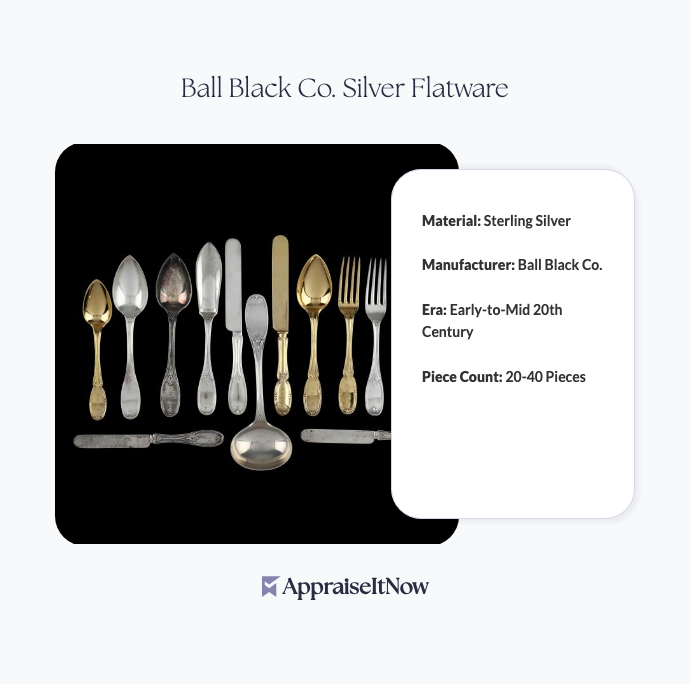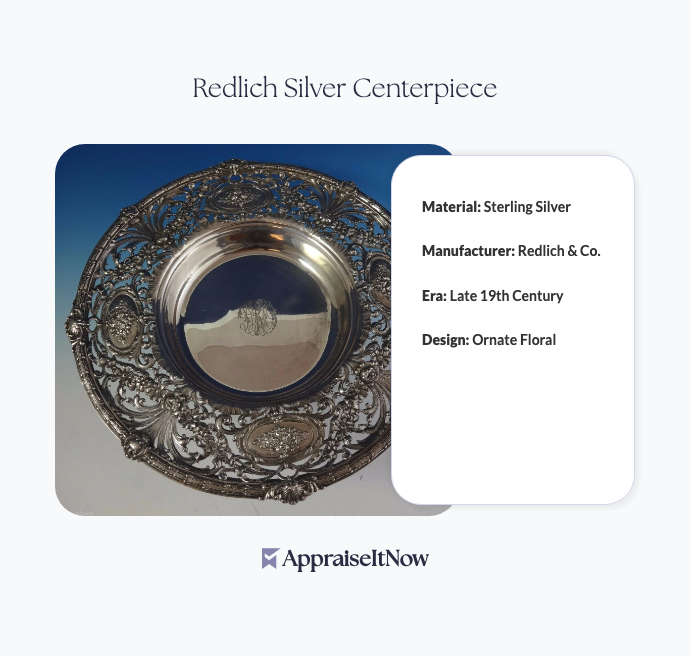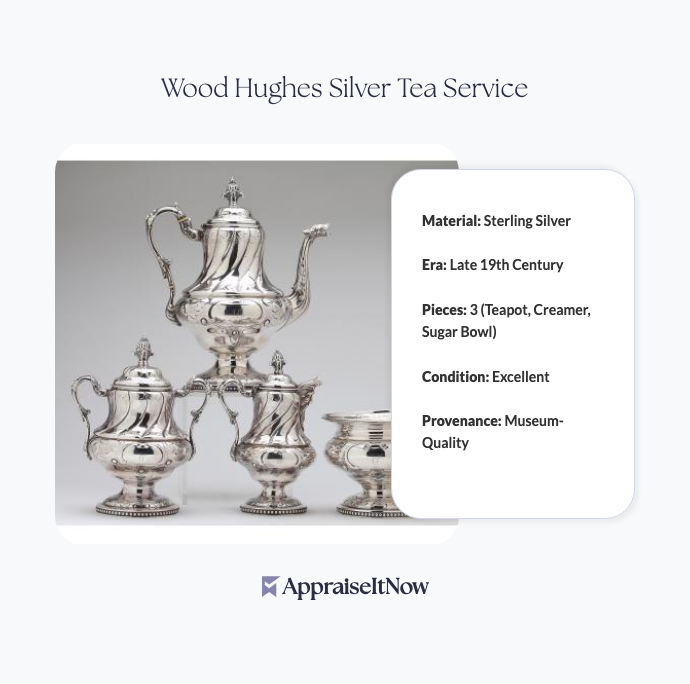<h1>How to Get Your Unger Brothers Silver Art Nouveau Appraised</h1>
<p>Unger Brothers silver pieces represent some of the finest American Art Nouveau craftsmanship from the late 19th and early 20th centuries. If you own one of these exquisite sterling silver items—whether it's a pitcher, serving tray, flatware set, or decorative object—understanding how to properly appraise it is essential for insurance, sale, estate planning, or simply verifying its value. Your Unger Brothers piece likely falls in the <strong>$2,500 to $4,000 range</strong>, but several factors can significantly influence its actual market worth.</p>
<h2>Understanding Unger Brothers' Place in American Silver History</h2>
<p>The Unger Brothers were renowned American silversmiths active from the 1890s onward, distinguished by their mastery of the Art Nouveau aesthetic. Unlike their European counterparts, American Art Nouveau silverwork—particularly from respected makers like Unger Brothers—developed a unique character emphasizing organic forms, naturalistic motifs, and exceptional craftsmanship. Each piece flows with the characteristic sinuous lines that define the Art Nouveau movement, making their work instantly recognizable to serious collectors.</p>
<p>What makes Unger Brothers particularly valuable today? The firm's reputation for quality, combined with the scarcity of their pieces, means each item commands significant collector interest. When considering <a href="/types/antique-silver">antique silver appraisals</a>, understanding a maker's historical significance directly impacts valuation methodology. Professional appraisers specializing in <a href="/types/antique-jewelry">antique jewelry and metalwork</a> recognize Unger Brothers as a top-tier American silversmith firm, elevating these pieces beyond typical sterling silver value.</p>
<div class="callout tip"><p><strong>Market Insight</strong></p>
<p>Unger Brothers pieces with documented provenance and pristine condition regularly exceed their base estimates by 30-50% at auction, making thorough appraisal documentation critical.</p></div>
<h2>Key Factors That Determine Your Piece's Value</h2>
<h3>Maker's Marks and Authentication</h3>
<p>Your Unger Brothers piece should bear identifying hallmarks that authenticate its origin and affect its appraisal value. The firm used distinct maker's marks—typically an intertwined "UB" or full "Unger Bros" signature—stamped on sterling silver items. Professional appraisers examine these marks under magnification to verify authenticity, as reproduction pieces occasionally appear in the market.</p>
<p>Beyond the maker's mark, look for secondary markings that provide additional valuation data. Sterling silver content stamps (typically ".925" or "STERLING") confirm material quality, while date marks and location stamps (Newark, New Jersey was their primary workshop) help establish the item's vintage. When seeking authentication, work with appraisers credentialed by recognized organizations like the <strong>American Society of Appraisers (ASA)</strong>, <strong>International Society of Appraisers (ISA)</strong>, or <strong>American Numismatic Association (ANA)</strong> who understand hallmark variations across production decades.</p>
<h3>Pattern, Rarity, and Design Complexity</h3>
<p>Unger Brothers produced numerous patterns throughout their manufacturing period, and rarity significantly influences value. A common flatware pattern might appraise differently than an elaborately decorated serving piece with intricate Art Nouveau motifs depicting nature scenes, mythological figures, or exceptional sculptural elements. The firm's most sought-after designs feature exceptional detail work—hand-chased surfaces, applied ornaments, or sculptural handles that demonstrate master craftsmen's skill.</p>
<p>The specific pattern you own matters tremendously. Did your piece appear in limited production runs, or was it a staple design manufactured in higher quantities? Professional appraisers compare your item against documented sales records, auction house catalogs, and collector references to establish its rarity tier. This research directly impacts valuation, as a rare Unger Brothers pattern might easily command $4,000 while a more common design settles closer to $2,500.</p>
<h3>Weight and Sterling Silver Content</h3>
<p>The weight of your Unger Brothers piece provides crucial valuation data. Sterling silver's intrinsic metal value fluctuates based on spot market prices, currently hovering around $23-25 per troy ounce. A substantial serving piece might contain 40-60 troy ounces of sterling silver, translating to $920-$1,500 in bullion value alone. However, the craftsmanship, design, and Unger Brothers attribution typically command a 150-300% premium above melt value for pieces in good condition.</p>
<p>Professional appraisers weigh your item using precision scales and verify sterling content through hallmark examination and sometimes XRF (X-ray fluorescence) testing for non-destructive metal verification. This establishes a "floor" value based on materials while the maker's reputation and design quality add substantial appreciation above that baseline.</p>
<div class="callout note"><p><strong>Valuation Principle</strong></p>
<p>A piece's value extends far beyond its silver content. The artistry, historical significance, and maker reputation of Unger Brothers work command premiums that reflect the item's status as fine decorative art rather than mere raw material.</p></div>
<h2>Condition's Critical Role in Market Value</h2>
<p>Your Unger Brothers piece's condition significantly impacts its appraisal. Collectors distinguish between several condition tiers, each affecting fair market value differently. Pieces showing original patina and light wear from period use often appraise higher than heavily restored examples among sophisticated collectors who value historical authenticity.</p>
<p>Common condition issues that reduce value include deep dents or creases (difficult to repair without compromising thin sterling silver), broken handles or spouts on functional pieces, and evidence of aggressive restoration or replating. Even minor repairs—solder marks from joining pieces, evidence of professional denting removal, or areas of replaced parts—should be documented in your appraisal. The appraiser's role includes precisely describing condition and documenting repairs, as these factors directly affect value calculations.</p>
<p>Restoration presents a complex valuation question. While professional conservation can enhance appearance, it often reduces value for serious collectors who prize original finishes. A piece with surface scratching and patina might appraise higher than an identical piece that's been polished bright or replated, counterintuitive as that may seem to casual owners. Understanding these collector preferences requires expertise in <a href="/blog/understanding-the-value-of-antique-silver-appraisals">understanding antique silver appraisals</a>.</p>
<h2>Provenance and Documentation</h2>
<p>Your piece's ownership history—its provenance—substantially influences appraisal value. Can you document previous owners? Do you have purchase receipts, auction catalogs, or family records explaining how the piece entered your collection? Established provenance reassures potential buyers and appraisers about authenticity while often supporting higher valuations.</p>
<p>Documentation matters particularly for estate situations or insurance purposes. When appraisers gather information about your Unger Brothers silver, they typically request: purchase dates and prices, previous professional appraisals, photographs from multiple angles, and any historical records connecting the piece to known collections. This documentation becomes essential for insurance claims or estate tax reporting, where professional appraisals provide the certified valuations required by financial institutions and tax authorities.</p>
<h2>Market Comparison and Recent Sales Data</h2>
<p>Understanding recent auction results and private sales provides valuable context for your appraisal. Unger Brothers pieces regularly appear at specialist auction houses, with results varying dramatically based on the specific item. A simple serving spoon might fetch $400-600, while an elaborate cake server with sculptural Art Nouveau handle work could command $800-1,200. Larger serving pieces, decorative boxes, or complete flatware sets substantially exceed these ranges.</p>
<p>When comparable sales data shows recent transactions for similar patterns in comparable condition, appraisers use this information to establish market value. The question of market demand—how eagerly collectors currently pursue specific Unger Brothers patterns—directly influences pricing. American Art Nouveau silver currently experiences strong collector interest, with values appreciating steadily as awareness grows among decorative arts collectors. Professional appraisers access auction databases and dealer networks to research current market dynamics affecting your specific piece.</p>
<div class="callout tip"><p><strong>Appraisal Advantage</strong></p>
<p>Current comparable sales data from the past 12-24 months provides the strongest valuation foundation. Appraisers who actively monitor the collector market can often identify your piece's recent price history at auction.</p></div>
<h2>Selecting a Qualified Appraiser for Your Unger Brothers Silver</h2>
<p>Not all appraisers possess expertise in American Art Nouveau silver. When seeking professional valuation, look for credentials from established appraisal organizations. The <strong>American Society of Appraisers (ASA)</strong>, <strong>International Society of Appraisers (ISA)</strong>, <strong>American Society of Jewelry Historians (ASJH)</strong>, and <strong>Certified Appraisers Guild of America (CAGA)</strong> maintain membership standards ensuring appraiser competency and ethical conduct.</p>
<p>Your appraiser should specialize in fine silver or decorative arts rather than providing general appraisals. Specialists in antique silver understand manufacturing techniques, design periods, and maker characteristics that generalists miss. When selecting an appraiser, ask about their experience with Unger Brothers specifically and request references from previous clients. Many qualified appraisers provide online appraisal services—you can submit clear photographs and detailed descriptions of your piece, allowing specialists to deliver USPAP-compliant valuations without requiring physical inspection for routine items.</p>
<p>For high-value pieces or those with unusual characteristics, in-person examination proves worthwhile. Appraisers can assess condition details, verify hallmarks definitively, and identify subtle variations that photographs might miss. The investment in a thorough, professional appraisal typically costs $150-400 depending on complexity, delivering documentation essential for insurance, sale, or estate purposes.</p>
<h2>Documentation Requirements for Your Appraisal</h2>
<p>When submitting your Unger Brothers silver for professional appraisal, prepare comprehensive documentation. High-quality photographs from multiple angles—top, bottom, side views, and close-ups of any hallmarks or damage—help appraisers evaluate your piece accurately. Include measurements (length, width, height, diameter as applicable) and estimated weight if you have access to a scale.</p>
<p>Describe the item's intended use: Is this for insurance coverage? Estate settlement? Preparing for sale? This context helps appraisers select appropriate valuation approaches. Insurance appraisals require replacement cost valuations reflecting what you'd pay to acquire a similar piece today. Estate appraisals may use fair market value standards appropriate for tax reporting. Sale appraisals might consider auction estimates reflecting expected market performance. Each purpose can yield different valuations because appraisers adjust their methodology based on the appraisal's intended use.</p>
<h2>Valuation Approaches and Methods</h2>
<p>Professional appraisers typically employ three approaches when evaluating Unger Brothers silver: comparable sales analysis, cost approach (materials plus labor), and income approach (for investment considerations). For your piece, the comparable sales method dominates—appraisers research similar Unger Brothers items that sold recently and adjust values based on condition, rarity, and market demand differences.</p>
<p>The cost approach matters less for antique silver since reproducing a piece's artistry in today's labor market costs far more than the resulting item's value. Instead, appraisers use cost data primarily to establish a floor valuation representing materials and basic craftsmanship. The difference between cost value and market value reflects the maker's reputation, historical significance, and collector demand driving true market worth.</p>
<p>Your appraisal report should detail the methodology employed, explain how comparable sales support the valuation conclusion, and describe all factors considered. Professional reports include detailed condition descriptions, high-quality photographs, specification documentation, and appraiser credentials. These comprehensive reports become essential when your insurance company requires substantiation or tax authorities question valuations on estate filings.</p>
<div class="callout note"><p><strong>Key Takeaway</strong></p>
<p>A certified appraisal of your Unger Brothers silver Art Nouveau piece provides authoritative documentation of its $2,500-$4,000 market value, protecting your investment through proper insurance coverage while establishing credible valuations for estate, tax, or sales purposes. Working with qualified appraisers credentialed by recognized organizations ensures your piece receives expert evaluation grounded in current market data and specialized knowledge of American Art Nouveau silver craftsmanship.</p></div>







.avif)







